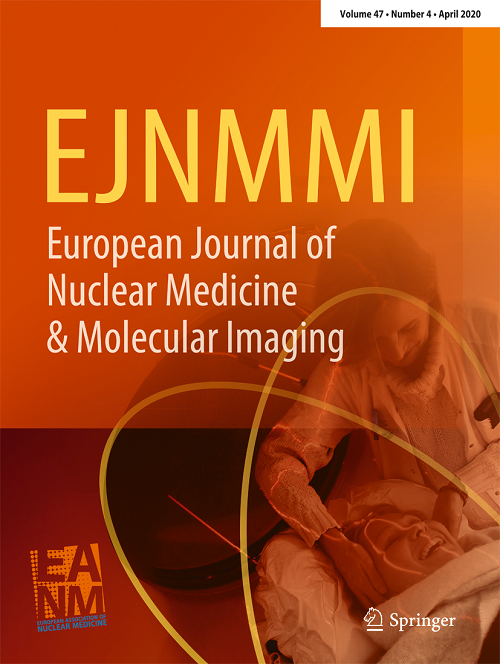68Ga-DOTATATE PET/CT与123I-MIBG SPECT/CT在中枢神经系统神经母细胞瘤和神经节神经母细胞瘤转移中的头对头前瞻性比较分析
IF 8.6
1区 医学
Q1 RADIOLOGY, NUCLEAR MEDICINE & MEDICAL IMAGING
European Journal of Nuclear Medicine and Molecular Imaging
Pub Date : 2025-07-10
DOI:10.1007/s00259-025-07440-7
引用次数: 0
摘要
目的评价和比较镓-68 DOTA-Tyr3-octreotate正电子发射断层扫描/计算机断层扫描(68Ga-DOTATATE PET/CT)和碘-123 metaiodobenzylguanidine单光子发射断层扫描/计算机断层扫描(123I-MIBG SPECT/CT)对中枢神经系统(CNS)神经母细胞瘤(NB)和神经节神经母细胞瘤(GNB)转移的诊断价值,并评价其对治疗管理的影响。方法本前瞻性研究纳入41例疑似中枢神经系统转移的NB和GNB患者。所有患者均在1周内接受123I-MIBG SPECT/CT和68Ga-DOTATATE PET/CT成像(中位数:3天;范围:1-7天)。两种成像方式的诊断性能在每个病人、每个病变和每个区域的基础上进行评估和比较。此外,我们还分析了临床管理决策发生变化和未发生变化的两组患者特征的差异。采用独立样本t检验、χ2检验、Fisher确切检验和Mann-Whitney U检验评价组间差异。结果40例(40/41,98%)患者确诊为中枢神经系统转移。中枢神经系统转移的平均年龄为63个月(范围:8-122个月)。与123I-MIBG SPECT/CT相比,68Ga-DOTATATE PET/CT在单个患者、单个病变和每个区域检测中枢神经系统转移方面表现出更优越的性能。此外,与123I-MIBG SPECT/CT相比,68Ga-DOTATATE PET/CT的结果导致51%(21/41)患者的临床管理发生变化,主要是由于新的或意想不到的发现。结论s68ga - dotatate PET/CT对NB和GNB合并中枢神经系统转移具有良好的诊断价值。此外,68Ga-DOTATATE PET/CT的结果导致51%的患者的治疗管理改变。本文章由计算机程序翻译,如有差异,请以英文原文为准。
A head-to-head prospective comparative analysis of 68Ga-DOTATATE PET/CT and 123I-MIBG SPECT/CT in central nervous system metastases of neuroblastoma and ganglioneuroblastoma.
PURPOSE
To assess and compare the diagnostic performance of Gallium-68 DOTA-Tyr3-octreotate positron emission tomography/computed tomography (68Ga-DOTATATE PET/CT) and Iodine-123 metaiodobenzylguanidine single photon emission computed tomography/computed tomography (123I-MIBG SPECT/CT) in detecting central nervous system (CNS) metastases of neuroblastoma (NB) and ganglioneuroblastoma (GNB), as well as to evaluate their impact on therapeutic management.
METHODS
This prospective study enrolled 41 patients with NB and GNB who were suspected of having CNS metastases. All patients underwent paired 123I-MIBG SPECT/CT and 68Ga-DOTATATE PET/CT imaging within 1 week (median: 3 days; range: 1-7 days). The diagnostic performance of the two imaging modalities was assessed and compared on a per-patient, per-lesion and per-region basis. Furthermore, the differences in patient characteristics between groups with and without changes in clinical management decisions were analyzed. Group differences were evaluated using the independent samples t-test, χ2 test, Fisher's exact test, and Mann-Whitney U test.
RESULTS
40 patients (40/41, 98%) were confirmed with CNS metastases. The mean age at CNS metastases was 63 months (range: 8-122 months). 68Ga-DOTATATE PET/CT exhibited superior performance compared with 123I-MIBG SPECT/CT in detecting CNS metastases on a per-patient, per-lesion and per-region basis. Additionally, the results of 68Ga-DOTATATE PET/CT led to changes in clinical management in 51% (21/41) of patients, primarily due to new or unexpected findings compared with those obtained using 123I-MIBG SPECT/CT.
CONCLUSIONS
68Ga-DOTATATE PET/CT demonstrated excellent diagnostic performance in NB and GNB patients with CNS metastases. Moreover, the findings from 68Ga-DOTATATE PET/CT led to a modification of the therapeutic management in 51% of patients.
求助全文
通过发布文献求助,成功后即可免费获取论文全文。
去求助
来源期刊
CiteScore
15.60
自引率
9.90%
发文量
392
审稿时长
3 months
期刊介绍:
The European Journal of Nuclear Medicine and Molecular Imaging serves as a platform for the exchange of clinical and scientific information within nuclear medicine and related professions. It welcomes international submissions from professionals involved in the functional, metabolic, and molecular investigation of diseases. The journal's coverage spans physics, dosimetry, radiation biology, radiochemistry, and pharmacy, providing high-quality peer review by experts in the field. Known for highly cited and downloaded articles, it ensures global visibility for research work and is part of the EJNMMI journal family.

 求助内容:
求助内容: 应助结果提醒方式:
应助结果提醒方式:


